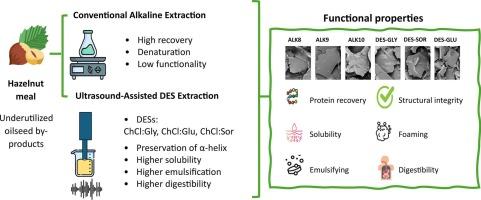超声波辅助深度共熔溶剂萃取与碱性萃取:榛子蛋白的功能和结构特性
IF 8.2
1区 农林科学
Q1 CHEMISTRY, APPLIED
引用次数: 0
摘要
本研究比较了传统碱性提取法和超声辅助深度共熔溶剂(DES-US)提取法从未充分利用的油籽副产品榛子粕中分离功能蛋白的方法。pH值为10时的碱性提取获得了最高的蛋白质回收率(260 mg/g)和提取效率(63%),而DES-US系统获得了中等可溶性回收率(~ 200-220 mg/g),但由于沉淀挑战,最终蛋白质收率(80 mg/g)降低。分子量谱证实,这两种方法都能有效保存主要的储存蛋白,包括7S和11S球蛋白以及2S白蛋白。二级结构分析显示碱性提取物中明显的ph诱导变性,而DES-US样品中α-螺旋保留率较高(例如,DES-GLU为95.7%,DES-SOR为81.6%)。与碱性提取物(58 - 63%)相比,DES-US系统也表现出更高的溶解度(75 - 76%)。DES-US (DES-GLY 15 m2/g)的乳化活性指数明显高于碱性样品(<6 m2/g),而DES-SOR的乳化稳定性在~ 60分钟达到峰值,而碱性样品为~ 5-6分钟。相反,碱性提取物表现出优越的起泡能力(对ALK10的起泡率为~ 50%)和稳定性(在120分钟时为~ 40 - 50%),而DES-US泡沫则不太稳定(FC为~ 10 - 25%)。与碱性处理相比,DES-US分离株的体外消化率最高(DES-SOR ~ 76%, DES-GLY ~ 75.1%)。这些结果表明,DES-US萃取为生产具有更好溶解度、乳化性和消化率的榛子蛋白提供了一种更环保、可扩展的策略,支持从农用工业残留物中开发可持续成分。本文章由计算机程序翻译,如有差异,请以英文原文为准。

Ultrasound-assisted deep eutectic solvent extraction versus alkaline extraction: Functional and structural properties of hazelnut proteins
This study compared conventional alkaline extraction and ultrasound-assisted deep eutectic solvent (DES–US) extraction for isolating functional proteins from hazelnut meal, an underutilized oilseed by-product. Alkaline extraction at pH 10 achieved the highest protein recovery (260 mg/g) and extraction efficiency (63 %), while DES–US systems yielded moderate soluble recoveries (∼200–220 mg/g) but showed reduced final protein yields (80 mg/g) due to precipitation challenges. Molecular weight profiles confirmed that both methods effectively preserved major storage proteins, including 7S and 11S globulins and 2S albumins. Secondary structural analyses revealed pronounced pH-induced denaturation in alkaline extracts, versus high α-helix retention in DES–US samples (e.g., DES-GLU 95.7 %, DES-SOR 81.6 %). DES–US systems also exhibited higher solubility (75–76 %) compared to alkaline extracts (58–63 %). Emulsifying activity index was significantly higher for DES–US (DES-GLY 15 m2/g) than alkaline (<6 m2/g), while emulsion stability peaked at ∼60 min for DES-SOR versus ∼5–6 min for alkaline samples. Conversely, alkaline extracts demonstrated superior foaming capacity (∼50 % for ALK10) and stability (∼40–50 % at 120 min), while DES–US foams were less stable (∼10–25 % FC). In vitro digestibility was highest for DES–US isolates (DES-SOR ∼76 %, DES-GLY ∼75.1 %) compared to alkaline treatments (∼57.6–65.3 %). These results suggest DES–US extraction offers a greener, scalable strategy for producing hazelnut proteins with improved solubility, emulsifying properties, and digestibility, supporting sustainable ingredient development from agro-industrial residues.
求助全文
通过发布文献求助,成功后即可免费获取论文全文。
去求助
来源期刊

Food Chemistry: X
CHEMISTRY, APPLIED-
CiteScore
4.90
自引率
6.60%
发文量
315
审稿时长
55 days
期刊介绍:
Food Chemistry: X, one of three Open Access companion journals to Food Chemistry, follows the same aims, scope, and peer-review process. It focuses on papers advancing food and biochemistry or analytical methods, prioritizing research novelty. Manuscript evaluation considers novelty, scientific rigor, field advancement, and reader interest. Excluded are studies on food molecular sciences or disease cure/prevention. Topics include food component chemistry, bioactives, processing effects, additives, contaminants, and analytical methods. The journal welcome Analytical Papers addressing food microbiology, sensory aspects, and more, emphasizing new methods with robust validation and applicability to diverse foods or regions.
 求助内容:
求助内容: 应助结果提醒方式:
应助结果提醒方式:


